HESI RN
Pharmacology HESI
1. A client is taking levothyroxine (Synthroid). The nurse instructs the client to notify the health care provider (HCP) if which of the following occurs?
- A. Fatigue
- B. Tremors
- C. Cold intolerance
- D. Excessively dry skin
Correct answer: B
Rationale: Tremors are a sign of excessive doses of levothyroxine, indicating hyperthyroidism. It is important for the client to report tremors to the healthcare provider to prevent complications associated with overdosing on levothyroxine.
2. A client is being monitored while receiving bethanechol chloride (Urecholine) for urinary retention. Which of the following indicates a therapeutic effect of this medication?
- A. Increased heart rate
- B. Increased peristalsis
- C. Passage of flatus
- D. Urinary output of 50 mL per hour
Correct answer: D
Rationale: Bethanechol chloride (Urecholine) is administered to stimulate the bladder and treat urinary retention. The therapeutic effect is indicated by an increased urinary output, as it demonstrates the medication's ability to prompt the bladder to empty. Increased heart rate and passage of flatus are unrelated to the therapeutic effects of bethanechol. Although bethanechol can increase peristalsis, the primary therapeutic goal is to address urinary retention.
3. A client is taking levothyroxine (Synthroid) for hypothyroidism. Which symptom would indicate to the nurse that the client is taking too much medication?
- A. Bradycardia
- B. Lethargy
- C. Tremors
- D. Constipation
Correct answer: C
Rationale: When a client is taking an excessive dose of levothyroxine (Synthroid), it can lead to symptoms of hyperthyroidism. Tremors are a common sign of excessive medication, along with tachycardia and insomnia. Bradycardia, lethargy, and constipation are typical symptoms of hypothyroidism, indicating that the client may require a higher dose of levothyroxine rather than too much.
4. Prednisone is prescribed for a client with diabetes mellitus who is taking Humulin neutral protamine Hagedorn (NPH) insulin daily. Which of the following prescription changes does the nurse anticipate during therapy with prednisone?
- A. An additional dose of prednisone daily
- B. A decreased amount of daily Humulin NPH insulin
- C. An increased amount of daily Humulin NPH insulin
- D. The addition of an oral hypoglycemic medication daily
Correct answer: C
Rationale: When prednisone is prescribed for a client with diabetes mellitus who is taking Humulin NPH insulin daily, the nurse should anticipate an increased amount of daily Humulin NPH insulin. Prednisone, a glucocorticoid, can elevate blood glucose levels, requiring an increase in insulin dosage to maintain optimal blood sugar control.
5. Mycophenolate mofetil (CellCept) is prescribed for a client as prophylaxis for organ rejection following an allogeneic renal transplant. Which of the following instructions does the nurse reinforce regarding administration of this medication?
- A. Administer on an empty stomach.
- B. Take the medication with a calcium-type antacid.
- C. Open the capsule and mix with food for administration.
- D. Contact the health care provider (HCP) if a sore throat occurs.
Correct answer: D
Rationale: The correct instruction for administering mycophenolate mofetil (CellCept) is to contact the healthcare provider (HCP) if unusual bleeding or bruising, sore throat, or other adverse effects occur. It is essential not to open or crush the capsules to maintain the medication's efficacy.
Similar Questions

Access More Features
HESI RN Basic
$89/ 30 days
- 50,000 Questions with answers
- All HESI courses Coverage
- 30 days access @ $89
HESI RN Premium
$149.99/ 90 days
- 50,000 Questions with answers
- All HESI courses Coverage
- 30 days access @ $149.99
